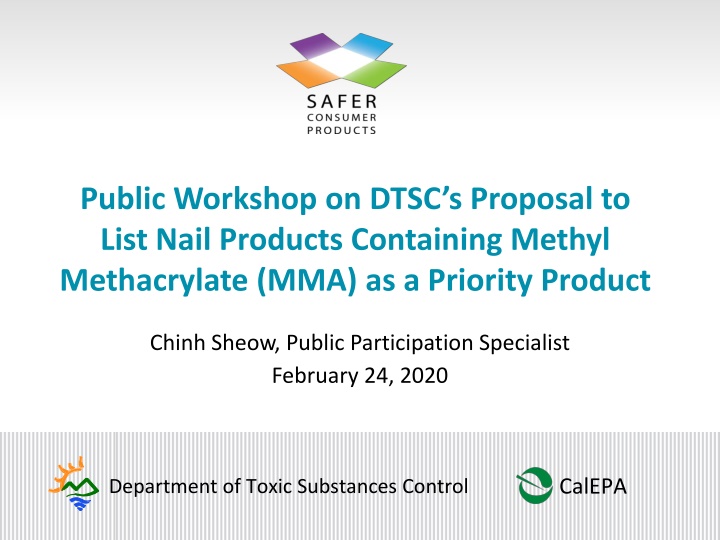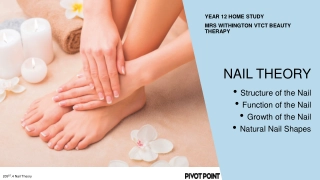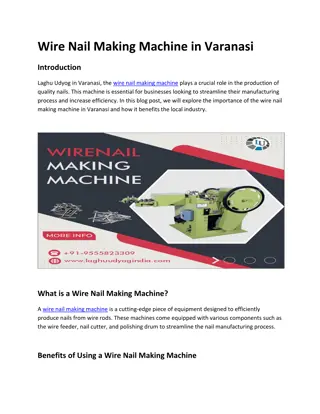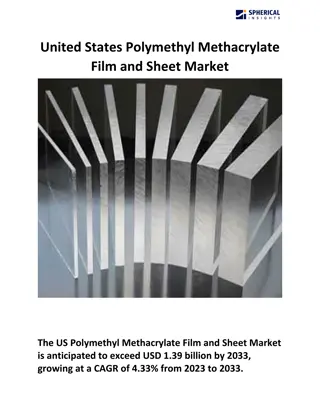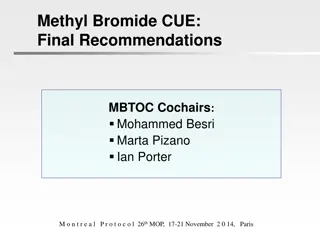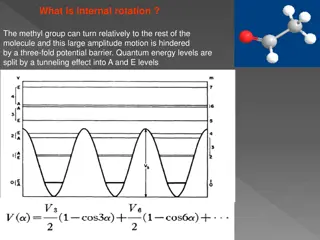DTSC Proposal to List Nail Products Containing Methyl Methacrylate (MMA)
The Department of Toxic Substances Control (DTSC) is holding a public workshop to discuss listing nail products containing Methyl Methacrylate (MMA) as a priority product due to potential exposures and adverse impacts. The presentation covers the scope of the product, hazard traits, exposure potential, updates on DTSC's efforts, additional chemical research, and the Healthy Nail Salon Recognition Program. The technical basis for the proposal is also outlined.
Uploaded on Sep 09, 2024 | 0 Views
Download Presentation

Please find below an Image/Link to download the presentation.
The content on the website is provided AS IS for your information and personal use only. It may not be sold, licensed, or shared on other websites without obtaining consent from the author.If you encounter any issues during the download, it is possible that the publisher has removed the file from their server.
You are allowed to download the files provided on this website for personal or commercial use, subject to the condition that they are used lawfully. All files are the property of their respective owners.
The content on the website is provided AS IS for your information and personal use only. It may not be sold, licensed, or shared on other websites without obtaining consent from the author.
E N D
Presentation Transcript
Public Workshop on DTSCs Proposal to List Nail Products Containing Methyl Methacrylate (MMA) as a Priority Product Chinh Sheow, Public Participation Specialist February 24, 2020 CalEPA Department of Toxic Substances Control
Webcast attendees, submit your questions or comments to: SaferConsumerProducts@dtsc.ca.gov CalEPA Department of Toxic Substances Control
23 Authoritative Lists referenced Updated quarterly ~ 200 new chemicals added Example chemicals: MMA Toluene Triphenyl phosphate Formaldehyde MEK Etc. https://dtsc.ca.gov/scp/candidate-chemicals-list/
Product evaluation process Rulemaking: - Research Refinement - Workshops - Supporting documents - Meetings - Profile - Comments - Public comments - Workshop
DTSCs Proposal to List Nail Products Containing Methyl Methacrylate (MMA) as a Priority Product Dicle Yardimci, PhD, Senior Hazardous Substances Engineer CalEPA Department of Toxic Substances Control
A Priority Product Must Meet These Criteria There are potential exposures to a Candidate Chemical in the product One or more exposures have the potential to contribute to or cause significant or widespread adverse impacts 7
Presentation Overview Methyl Methacrylate (MMA) in Nail Products Scope of product/chemical definitions Hazard traits Exposure potential DTSC Nail Product Efforts Updates Additional chemical research in nail products Analytical laboratory study Information call-in Healthy Nail Salon Recognition (HNSR) Program 8
The Technical Basis for this Proposal 9
Scope of Product: Nail Coatings Nail polish Lacquer Enamel Base coat Top coat Gel polish Hard gel Shellac Nail art Airbrush nail art paint 10
Scope of Product: Acrylic Nails Acrylic nails have two components: Liquid acrylic monomer Acrylic powder MMA is a liquid acrylic monomer Acrylic powder containing polymerized methyl methacrylate (PMMA) may contain residual, unpolymerized MMA 11
Scope of Candidate Chemical: Methyl Methacrylate (MMA) Clear, colorless liquid Volatile liquid monomer Listed as a toxic air contaminant (TAC) by California Air Resources Board (CARB) 12
Regulations on MMA-containing Nail Products The U.S. Food and Drug Administration (FDA) banned nail products containing 100% MMA in the market (early 1970s) California s Board of Barbering and Cosmetology prohibited any product that contains MMA as an intentionally added ingredient in licensed salons and cosmetology schools (2015) Besides California, 30 other states have prohibited any product that contains MMA as an ingredient in licensed salons and cosmetology schools 13
Hazard Traits of Methyl Methacrylate (MMA) Dermal toxicity Respiratory toxicity Well demonstrated in human exposures and animal models 14
Dermal Toxicity of Methyl Methacrylate (MMA) Allergic contact dermatitis (ACD) Rajan et al. (2016) 21 of 53 occupational exposure cases were from nail products 51% of industry workers including nail technicians were patch tested positive for MMA Gatica-Ortega et al. (2018) 4 consumers applied gel polish at home reported ACD 3 of 4 consumers patch tested positive for methacrylates including MMA Skin irritation and inflammation, nail damage, nail discoloration, infection, redness, and pain 15
Respiratory Toxicity of Methyl Methacrylate (MMA) Listed as a toxic air contaminant by CARB Respiratory tract irritation Various industry workers including nail salon workers occupationally exposed to MMA (Borak et al. 2011) Animal studies (adverse lung effects and toxic to nasal tissues) Linked to occupational asthma A case study reported 6 of 9 occupational asthma cases from acrylate-containing acrylic nails in nail technicians (Kwok et al. 2014) Nail technicians exposed to methacrylate monomers in acrylic nails and gel nails reported shortness of breath, coughing, and wheezing (Arora et al. 2017, Sauni et al. 2008) 16
Exposure to Methyl Methacrylate (MMA) from Retail Nail Products Mintel s Global New Products Database (2010-2019) 4 nail coatings and acrylic nail products in U.S. 19 nail products worldwide Environmental Working Group s (EWG) Skin Deep cosmetics database (2019) 24 nail coatings in U.S. U.S. EPA s Chemical and Product Categories (CPCat) database (2017) 2 acrylic nail products in U.S. 17
Exposure to Methyl Methacrylate (MMA) Exposure Routes Inhalation Dermal Presence of MMA Present in retail products for home use Detected in salon indoor air 18
Populations Exposed to Methyl Methacrylate (MMA) from Nail Products Nail product consumers including children and pregnant women Home environments may be poorly ventilated Consumers are not trained Products are generally not labeled with exposure potential No minimum age limit on purchasing or use of products Nail salon workers, nail salon patrons, their children, and their customers 19
Exposure to Methyl Methacrylate (MMA) from Retail Nail Products in U.S. Over 100 million (60%) women use nail products annually Annual nail product sales > 1 billion dollars 62% of total sales represent products that may contain MMA 13% acrylic nail product sales 49% nail polish sales 20
Home Exposure to MMA from Retail Nail Products Survey in northern and central California households (Wu et al. 2010) Nail polish use patterns at home 45% children 5 or younger 79% children older than 5 53% adults younger than 55 39% adults older than 55 Parental use of nail products influence children s use Parents use nail products on their children 21
MMA Detected in Indoor Air of California Nail Salons Study in 8 California nail salons (Nguyen 2016) Detected MMA in all salons (average concentration 3.37 ppm) Significant positive correlations found between MMA and total volatile organic compound (VOC) concentrations Number of acrylic nail services and total VOC concentrations (including MMA) Number of gel nail services and MMA concentrations 22
MMA Detected in Indoor Air of Nail Salons Study in 6 Colorado nail salons (Lamplugh et al. 2019) MMA was measured in 2 salons (range 0.07 to 1.1 ppm) MMA can be purchased from Colorado nail supply stores Study in 25 nail salons in New York, New Jersey, and Philadelphia (Ma et al. 2019) MMA was measured in all the salons (range 0.05 to 21.5 ppm) One salon was offering artificial nail services on the test day and measured MMA concentration as 941 ppm 23
Summary Well characterized hazard traits Present in retail nail products Detected in salon indoor air Potential for exposure Potential to cause or contribute to significant or widespread adverse impacts 24
Alternatives to Methyl Methacrylate (MMA) in Nail Products Known alternative: Ethyl Methacrylate (EMA) DTSC has made no determination on its safety Not a complete list of alternatives 25
Proposed Priority Product Potential for exposure to methyl methacrylate (MMA) from nail products Potential for methyl methacrylate (MMA) exposure to cause or contribute to significant or widespread adverse impacts 26
DTSC Nail Product Efforts Updates Research on other chemicals in nail products DTSC s analytical laboratory study Information call-in Healthy Nail Salon Recognition (HNSR) Program 27
Nail Products Containing Toluene as a Priority Product DTSC proposed nail products containing toluene as a Priority Product, March 2019 External Science Panel Review (ESPR), Fall 2019 Rulemaking, Fall 2020 28
Chemicals Researched Acrylic acid Di(2-ethylhexyl)phthalate t-butyl alcohol N-methylpyrrolidone Carbon black Aluminum powder Isopropyl alcohol Phosphoric acid Acetone 29
Acrylic Acid Used in nail polish and gel polish to provide longer lasting effect, faster drying, and easier removal Respiratory, dermal, and ocular toxicant DTSC has not found studies with acrylic acid as a target analyte in salon indoor air Currently evaluating 30
Di(2-ethylhexyl)phthalate Used in nail polish as a plasticizer Developmental, reproductive, and endocrine toxicant and animal carcinogen Significant exposure from nail products not expected Currently evaluating 31
t-Butyl Alcohol Used in nail polishes and polish removers as a solvent Animal carcinogen Potential inhalation exposure Currently evaluating 32
N-Methylpyrrolidone Used in nail polish removers as a solvent Mintel database lists 1 polish remover in last 5 years May be present in other nail product categories Carcinogen, reproductive and developmental toxicant Phased out in European Union Currently evaluating 33
Carbon Black Used in artificial nails, UV gel, and nail polish as a colorant Potential carcinogen and aquatic toxicant Significant inhalation exposure is not expected Not recommending for prioritization at this time 34
Aluminum Powder Used in nail polish as a colorant Respiratory and neurological toxicant Significant inhalation exposure is not expected Not recommending for prioritization at this time 35
Isopropyl Alcohol Used in nail coatings and nail polish removers as a solvent Eye, nose, and respiratory tract irritant Unlikely to cause significant adverse impacts Not recommending for prioritization at this time 36
Phosphoric Acid Used in nail polish and gel polish as a pH adjuster Respiratory toxicant Low potential for adverse impacts Not recommending for prioritization at this time 37
Acetone Used in nail polish removers and nail coatings as a solvent Neurotoxicant, eye and respiratory irritant CARB exempts only acetone as a volatile organic compound in nail polish removers Not recommending for prioritization at this time 38
Chemicals & Products Currently Researching Products Primers, bonders, bond-aid products Nail dry sprays and aerosols Glues/resins Artificial nail products, such as acrylic powders and liquids Chemicals Methyl ethyl ketone Tosylamide formaldehyde resin and formaldehyde Triphenyl phosphate 39
Analytical Lab Study of Nail Products Determine the presence and concentrations of Candidate Chemicals in retail and professional-use nail products 157 nail products from 21 different product types Nail coatings Acrylic nails Nail glues and primers Thinners and hardeners Nail dry sprays Airbrush cleaners Initiated product testing, Fall 2019 40
Information Call-In SCP regulations (Section 69501.4) give DTSC authority to conduct an information call-in May apply to all manufacturers, importers, assemblers, and retailers of a specific chemical or product or group of chemicals or products Information call-in goals Fill data gaps related to nail products Improve understanding and reduce research time Initiate information call-in, early 2020 41
Healthy Nail Salon Recognition (HNSR) Program Established to prevent, minimize, or reduce nail salon workers and their customers exposure to toxic chemicals in nail products Intended for local government agencies in California that create voluntary HNSR programs HNSR Program Guidelines: https://dtsc.ca.gov/wp- content/uploads/sites/31/2018/10/AB2125-HNSR-Program- Guidelines.pdf Outreach and implementation planning 42
Next Steps Receive public comments on proposed Priority Product listing of nail products containing methyl methacrylate (MMA) Closes March 20, 2020 Provide comments at CalSAFER: https://calsafer.dtsc.ca.gov/cms/commentpackage/?rid=12 750 Ongoing chemical research Analytical lab study Information call-in HNSR Program outreach and implementation 43
Clarifying Questions and Comments Webcast attendees, submit your questions or comments to: SaferConsumerProducts@dtsc.ca.gov 44
Questions for Stakeholders on Proposed Priority Product 1. Are the nail product definitions clear and complete? 2. At what concentration is MMA present as unreacted, residual in polymethyl methacrylate (PMMA)-containing nail products? 3. What could be the sources of MMA detection in salons after MMA was prohibited in salons? 4. Are there known alternatives to MMA in nail products? CalSAFER: https://calsafer.dtsc.ca.gov/cms/commentpackage/?rid=12750 45
General Questions and Comments Webcast attendees, submit your questions or comments to: SaferConsumerProducts@dtsc.ca.gov 46
Contact Information Join our E-list to get updates: http://bit.ly/scpupdates General questions: SaferConsumerProducts@dtsc.ca.gov Media inquiries: Sanford.Nax@dtsc.ca.gov Technical questions: Andre.Algazi@dtsc.ca.gov and Dicle.Yardimci@dtsc.ca.gov Meeting requests: Heather.Kessler@dtsc.ca.gov 47
